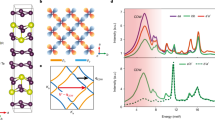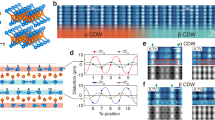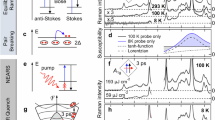Abstract
Condensed-matter analogues of the Higgs boson in particle physics allow insights into its behaviour in different symmetries and dimensionalities1. Evidence for the Higgs mode has been reported in a number of different settings, including ultracold atomic gases2, disordered superconductors3, and dimerized quantum magnets4. However, decay processes of the Higgs mode (which are eminently important in particle physics) have not yet been studied in condensed matter due to the lack of a suitable material system coupled to a direct experimental probe. A quantitative understanding of these processes is particularly important for low-dimensional systems, where the Higgs mode decays rapidly and has remained elusive to most experimental probes. Here, we discover and study the Higgs mode in a two-dimensional antiferromagnet using spin-polarized inelastic neutron scattering. Our spin-wave spectra of Ca2RuO4 directly reveal a well-defined, dispersive Higgs mode, which quickly decays into transverse Goldstone modes at the antiferromagnetic ordering wavevector. Through a complete mapping of the transverse modes in the reciprocal space, we uniquely specify the minimal model Hamiltonian and describe the decay process. We thus establish a novel condensed-matter platform for research on the dynamics of the Higgs mode.
This is a preview of subscription content, access via your institution
Access options
Access Nature and 54 other Nature Portfolio journals
Get Nature+, our best-value online-access subscription
$32.99 / 30 days
cancel any time
Subscribe to this journal
Receive 12 print issues and online access
$259.00 per year
only $21.58 per issue
Buy this article
- Purchase on SpringerLink
- Instant access to full article PDF
Prices may be subject to local taxes which are calculated during checkout




Similar content being viewed by others
References
Pekker, D. & Varma, C. M. Amplitude/Higgs modes in condensed matter physics. Annu. Rev. Condens. Matter Phys. 6, 269–297 (2014).
Endres, M. et al. The ‘Higgs’ amplitude mode at the two-dimensional superfluid/Mott insulator transition. Nature 487, 454–458 (2012).
Sherman, D. et al. The Higgs mode in disordered superconductors close to a quantum phase transition. Nat. Phys. 11, 188–192 (2015).
Rüegg, C. et al. Quantum magnets under pressure: controlling elementary excitations in TlCuCl3 . Phys. Rev. Lett. 100, 205701 (2008).
Khaliullin, G. Excitonic magnetism in Van Vleck-type d4 Mott insulators. Phys. Rev. Lett. 111, 197201 (2013).
Meetei, O. N., Cole, W. S., Randeria, M. & Trivedi, N. Novel magnetic state in d4 Mott insulators. Phys. Rev. B 91, 054412 (2015).
Nakatsuji, S., Ikeda, S. I. & Maeno, Y. Ca2RuO4: new Mott insulators of layered ruthenate. J. Phys. Soc. Jpn 66, 1868–1871 (1997).
Braden, M., André, G., Nakatsuji, S. & Maeno, Y. Crystal and magnetic structure of Ca2RuO4: magnetoelastic coupling and the metal-insulator transition. Phys. Rev. B 58, 847–861 (1998).
Friedt, O. et al. Structural and magnetic aspects of the metal-insulator transition in Ca2−xSrxRuO4 . Phys. Rev. B 63, 174432 (2001).
Anisimov, V. I., Nekrasov, I. A., Kondakov, D. E., Rice, T. M. & Sigrist, M. Orbital-selective Mott-insulator transition in Ca2−xSrxRuO4 . Eur. Phys. J. B 25, 191–201 (2002).
Fang, Z., Nagaosa, N. & Terakura, K. Orbital-dependent phase control in Ca2−xSrxRuO4 . Phys. Rev. B 69, 045116 (2004).
Liebsch, A. & Ishida, H. Subband filling and Mott transition in Ca2−xSrxRuO4 . Phys. Rev. Lett. 98, 216403 (2007).
Gorelov, E. et al. Nature of the Mott transition in Ca2RuO4 . Phys. Rev. Lett. 104, 226401 (2010).
Mizokawa, T. et al. Spin–orbit coupling in the Mott insulator Ca2RuO4 . Phys. Rev. Lett. 87, 077202 (2001).
Haverkort, M. W., Elfimov, I. S., Tjeng, L. H., Sawatzky, G. A. & Damascelli, A. Strong spin–orbit coupling effects on the Fermi surface of Sr2RuO4 and Sr2RhO4 . Phys. Rev. Lett. 101, 026406 (2008).
Fatuzzo, C. G. et al. Spin–orbit-induced orbital excitations in Sr2RuO4 and Ca2RuO4: a resonant inelastic X-ray scattering study. Phys. Rev. B 91, 155104 (2015).
Taniguchi, H. et al. Anisotropic uniaxial pressure response of the Mott insulator Ca2RuO4 . Phys. Rev. B 88, 205111 (2013).
Nakamura, F. et al. From Mott insulator to ferromagnetic metal: a pressure study of Ca2RuO4 . Phys. Rev. B 65, 220402(R) (2002).
Matsumoto, M., Normand, B., Rice, T. M. & Sigrist, M. Field- and pressure-induced magnetic quantum phase transitions in TlCuCl3 . Phys. Rev. B 69, 054423 (2004).
Sommer, T., Vojta, M. & Becker, K. Magnetic properties and spin waves of bilayer magnets in a uniform field. Eur. Phys. J. B 23, 329–339 (2001).
Kunkemöller, S. et al. Highly anisotropic magnon dispersion in Ca2RuO4: evidence for strong spin orbit coupling. Phys. Rev. Lett. 115, 247201 (2015).
Podolsky, D. & Demler, E. Properties and detection of spin nematic order in strongly correlated electron systems. New J. Phys. 7, 59 (2005).
Giamarchi, T., Rüegg, C. & Tchernyshyov, O. Bose–Einstein condensation in magnetic insulators. Nature 4, 198–204 (2008).
Merchant, P. et al. Quantum and classical criticality in a dimerized quantum antiferromagnet. Nat. Phys. 10, 373–379 (2014).
Podolsky, D., Auerbach, A. & Arovas, D. P. Visibility of the amplitude (Higgs) mode in condensed matter. Phys. Rev. B 84, 174522 (2011).
Gazit, S., Podolsky, D. & Auerbach, A. Fate of the Higgs mode near quantum criticality. Phys. Rev. Lett. 110, 140401 (2013).
Kenzelmann, M. et al. Multiparticle states in the S = 1 chain system CsNiCl3 . Phys. Rev. Lett. 87, 017201 (2001).
Zaliznyak, I. A., Lee, S.-H. & Petrov, S. V. Continuum in the spin-excitation spectrum of a Haldane chain observed by neutron scattering in CsNiCl3 . Phys. Rev. Lett. 87, 017202 (2001).
Stone, M. B., Zaliznyak, I. A., Hong, T., Broholm, C. L. & Reich, D. H. Quasiparticle breakdown in a quantum spin liquid. Nature 440, 187–190 (2006).
Masuda, T. et al. Dynamics of composite Haldane spin chains in IPA-CuCL3 . Phys. Rev. Lett. 96, 047210 (2006).
Nakatsuji, S. & Maeno, Y. Synthesis and single-crystal growth of Ca2−xSrxRuO4 . J. Solid State Chem. 156, 26–31 (2001).
Ewings, R. A. et al. HORACE: software for the analysis of data from single crystal spectroscopy experiments at time-of-flight neutron instruments. Nucl. Instrum. Methods Phys. Res. A 884, 132–142 (2016).
Acknowledgements
We acknowledge financial support from the German Science Foundation (DFG) via the coordinated research programme SFB-TRR80, and from the European Research Council via Advanced Grant 669550 (Com4Com). The experiments at Oak Ridge National Laboratory’s Spallation Neutron Source were sponsored by the Division of Scientific User Facilities, US DOE Office of Basic Energy Sciences. J.C. was supported by GACR (project no. GJ15-14523Y) and by MSMT CR under NPU II project CEITEC 2020 (LQ1601).
Author information
Authors and Affiliations
Contributions
M.K., G.H.R. and D.P.C. grew the single crystals. A.J., M.K. and J.P. characterized and co-aligned the crystals. A.J., M.K., J.P. and B.J.K. performed INS experiments and analysed the data. D.L.A., J.T.P. and A.I. supported the INS experiments. G.K. developed the theoretical model. J.C. and B.J.K. performed the numerical calculations. B.J.K. wrote the manuscript with contributions from G.K., J.C., B.K., J.P., A.J. and M.K. and discussions with all authors. B.J.K. and B.K. managed the project.
Corresponding authors
Ethics declarations
Competing interests
The authors declare no competing financial interests.
Supplementary information
Supplementary information
Supplementary information (PDF 924 kb)
Rights and permissions
About this article
Cite this article
Jain, A., Krautloher, M., Porras, J. et al. Higgs mode and its decay in a two-dimensional antiferromagnet. Nature Phys 13, 633–637 (2017). https://doi.org/10.1038/nphys4077
Received:
Accepted:
Published:
Issue date:
DOI: https://doi.org/10.1038/nphys4077
This article is cited by
-
Time-hidden magnetic order in a multi-orbital Mott insulator
Nature Physics (2025)
-
Quantum coarsening and collective dynamics on a programmable simulator
Nature (2025)
-
Resolving the orbital character of low-energy excitations in Mott insulator with intermediate spin-orbit coupling
Communications Physics (2025)
-
Spin-orbit entanglement driven by the Jahn-Teller effect
Nature Communications (2024)
-
Chiral and flat-band magnetic quasiparticles in ferromagnetic and metallic kagome layers
Nature Communications (2024)



